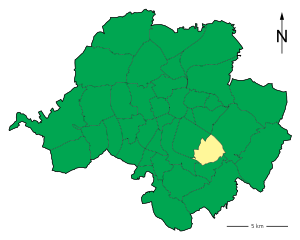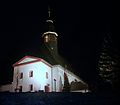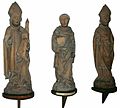Chemnitz-Reichenhain
|
Reichenhain district and statistical district No. 43 of Chemnitz |
|
|---|---|
| Coordinates | 50 ° 47 '55 " N , 12 ° 57' 25" E |
| surface | 3.96 km² |
| Residents | 2740 (Dec. 31, 2013) |
| Population density | 692 inhabitants / km² |
| Incorporation | Jan. 1, 1929 |
| Post Code | 09125 |
| prefix | 0371 |
| Transport links | |
| Federal road |
|
| tram | 2 |
| bus | 53, 33, 56, 207 |
Reichenhain is a district of the city of Chemnitz . It is located around 4.5 km southeast of Chemnitz city center .
location
The place stretches from the lowlands on the Zwönitz , first gradually in a flat hollow, then up a steep hill to the B 174 . Because of its relatively protected location, Reichenhain is said to have been rich in nut trees in the past. Bordering on Adelsberg , Bernsdorf , Altchemnitz and Erfenschlag , the Reichenhainer Flur extends over an area of 435 hectares (1900).
history
Reichenhain was first mentioned in 1346 in the register of the diocese of Meißen and was incorporated on October 1, 1929 and a district of Chemnitz.
In 1464 the place was mentioned in a document as "Richenheym" and in 1485 as "Reichenheym" (= 'to the rich, fertile settlement area'). The two-row Waldhufendorf was never a monastery village of Chemnitz . It belonged together with Weißbach , Dittersdorf , Kemtau , Einsiedel and Erfenschlag since 1696 to the dominion of Weißbach with Dittersdorf in the Electoral Saxon office of Wolkenstein and came to the office of Chemnitz in 1832 and in 1875 to the administrative authority of Chemnitz .
In August 1790, the Reichenhain farmers were the first to join the anti-feudal Saxon peasant uprising : "It all comes from Reichenhayn because they have read and learned that in other countries different subjects opposed their jurisdiction". The farmers refused the performance of compulsory labor , but were put off by promises until the Saxon government was master of the situation again. Their spokesman, the Reichenhainer liege judge Carl David Eichler, who owned a sizable farm estate worth 700 thalers, was sentenced to prison .
In addition to agriculture , domestic industry played a role in Reichenhain . For the period 1820 reported A. Schumann: "In the houses you can see a lot of chairs in progress, which partly Cattun and other cotton manufacturers, partly Strumpfwaare all kinds and braids deliver."
At Jägerschlößchenstrasse 94 and 105, two three-sided courtyards typical of the Ore Mountains have been preserved as objects of rural folk architecture . The last of the chestnut trees with edible fruits ( chestnuts ) that used to exist in Reichenhain is located nearby . The tree is several hundred years old.
New chestnut trees were planted as street trees on Eichlerstraße in 2008 on behalf of the municipal green space office in Reichenhain in order to continue the tradition. Also worth mentioning is the former feudal court and the residential stable at Jägerschlößchenstrasse 104, as well as several rural houses from the first half of the 19th century on Gornauer Strasse and Richterweg.
In the decades after 1929, the incorporation into the city of Chemnitz led to hardly any change in the predominantly village character of the place, apart from the Wilhelminian style development on the two main streets, the so-called war settlement on the edge of the Niedereinsiedler forest and some residential houses and the first post-war school building on Genossenschaftsweg.
In the period from 1992 to 2007, Reichenhain showed the strongest population growth of all Chemnitz districts with +144%. The reason for this lies in the construction of the residential areas Kreyßighof (1993), Mühlberg (1995), Orchideengarten (1997), Auf der Kirchwiese (2003), Pfarrlehn (2006) and the expansion of the development on Schenkenberg. These new residential areas are almost exclusively built with single-family and terraced houses.
On January 12, 2005 the Heimatverein Chemnitz-Reichenhain e. V. founded, which u. a. employed in three working groups on local history, economics and urban planning.
Soviet cemetery
In 1946 a 12,200 m² Soviet cemetery was laid out on Schenkenberg in Reichenhain for 1,130 prisoners of war and slave labor . This cemetery was established (as many such cemeteries in Germany after World War II ) by one of the Allies initiated Umbettungsaktion for their scattered in many places buried the dead from the war years.
In the center of the cemetery there is a 10 m high obelisk on a star-shaped pedestal, flanked by two life-size stone soldiers . The memorial for the soldiers of the Red Army was created by Hanns Diettrich in 1947 and restored in 1996 by his son Frank Diettrich with the support of the Free State of Saxony .
Another memorial stone was erected in 1946 on behalf of the United Nations and consists of a simple, almost three-meter-high square sandstone stele . The names of 268 Soviet forced laborers who were employed in factories in the Chemnitz region are engraved on the four sides.
Faradit / VEB Rohr- und Kaltwalzwerk / Faradit Rohrwerk GmbH
The Faradit plant on Bernsdorfer Strasse in Reichenhain was founded in 1904 by Maximilian Karl Haas , and from 1910 headed the company "Faradit" Isolierrohr-Werke Max Haas GmbH . The name Faradit is derived from the British physicist Michael Faraday , whose knowledge of electroplating and electromagnetism (induction welding process) forms an important production basis for Faradit. Insulating pipes for electrical systems were already being manufactured in 1910. The company was converted into a stock corporation under the same name in 1912 . In the following years several patents for steel tube production were registered. For the first time in the world, longitudinal welding of steel pipes using the electrical resistance method with a roll transformer was introduced here in 1930.
The share capital in 1912 was 1.5 million marks , it was increased to 14 million marks (1922) during the period of high inflation and after the currency stabilization in 1924 it was converted to 1.96 million Reichsmarks . The global economic crisis that began in 1929 quickly brought the company into economic difficulties, and by the end of 1931 the losses had risen to 646,000 Reichsmarks. Since no improvement was to be expected, the general meeting of the stock corporation on March 31, 1932 decided to liquidate it . After the term Faradit was deleted from the company, Faradit Rohr- und Walzwerk AG was founded as a rescue company at the beginning of 1934 - when after the Nazis' seizure of power, the Faradit Rohr- und Walzwerk AG was founded, which from the old company its younger (from 1912) production facilities as well Acquired patents and mortgages against own shares with a nominal value of 392,000 Reichsmarks. Ownership and management remained broadly unchanged at this "new beginning": sole director was Walter Hengst Berg , the Supervisory Board sat Carl Siems (owner and director of Tüllfabrik Floeha AG as Faradit-major shareholder) and the Chemnitz entrepreneur Fritz Vogel .
In 1948 the company merged with the Kopex company and began producing flexible insulating pipes, among other things.
In the GDR, the plant was connected to the Riesa pipe combine and was known as the pipe and cold rolling mill. The steel strip that is cold-rolled in the company is mainly used for our own tube production. To this day, the plant is a specialist in longitudinally welded steel pipes, which are mainly used in scaffolding and plant construction.
In 1953, the plant was given a siding with the construction of a 3.7 km long connecting line, which branches off the DB line between the Chemnitz Süd station and the Chemnitz-Reichenhain stop and has seven secondary connections. This siding was closed on April 25, 2015.
In 2001 the plant returned to its historic name, Faradit. After successful modernization and restructuring, Faradit Rohrwerk GmbH continues to produce longitudinally welded steel pipes according to the latest standards as well as traffic sign stands. In November 2006 the Altrad Group took over the plant. Insolvency proceedings were opened in March 2012 .
In 2001, a fundamental reconstruction and modernization of the approx. 80,000 m² site at Bernsdorfer Straße 291 began. The fundamental renovation of previously unused office, warehouse and production areas made it possible for numerous medium- sized companies in the manufacturing sector and in the Forwarding and logistics area possible. The modern commercial location benefits above all from a modern infrastructure and the convenient location on the Chemnitz Südring (or Südverbund). The industrial site is now owned and managed by Faradit Gewerbepark GmbH . Various companies in the transport, storage and production industries have now rented their premises there.
Reichenhain primary school
The first Reichenhain school was founded in 1558. Its foundation probably goes back to the "general visitation" of Elector August 1556 to church and school matters. In 1856 134 pupils, in 1869 already 208 pupils and in 1915 finally 392 pupils are registered, who are taught by three teachers and one assistant teacher. The classroom was on the Kirchschullehn near the Reichenhainer Christ Church. In 1870 a new school building was erected at Pfaffensteig 2, which was enlarged by several extensions in the period after the First World War .
After the destruction of the Reichenhainer School in World War II on March 5, 1945 and the subsequent use of various emergency solutions in the post-war period, the foundation stone was laid in 1949 and the new Reichenhainer School on Genossenschaftsweg 2 was handed over on October 14, 1950. It was the first new school building after the Second World War in Chemnitz. A seating niche portal from the old Chemnitz city center (Innere Klosterstraße) was installed as the main entrance, which was built in 1603 in the architectural forms of the Renaissance . A sandstone sculpture by the sculptor Hanns Dietrich showing children playing music was set up on the staircase leading to the portal terrace .
In 1962 the school became a ten-class general polytechnic high school . From 1977 to 1992 the school was named Prof. Johann Riesner Oberschule . In the inner courtyard of the three-wing building, a portrait bust reminds of the work of the Chemnitz honorary citizen Hans Riesner, which is also connected with the school and its reconstruction.
The Reichenhainer School has been a primary school since 1992 .
Reichenhainer Christ Church
The Reichenhain Church is a single-nave hall building with a flat ceiling and a straight choir closure as well as a gallery from around 1778 and is located in the upper part of the village. The wooden pulpit altar dates from around 1780.
From a previous building (around 1490), two arched curtain windows have survived on the south side , which were probably added around 1820. Three figures of Saints Wolfgang , Nikolaus and Franziskus kept in the church belonged to a late Gothic altar that is no longer preserved .
The community was first mentioned as a parish in 1346 and has been Protestant since the introduction of the Reformation in Saxony in 1539 . From 1565, entries about baptisms, weddings and burials have been preserved in the church book.
In 1545 Oberhermersdorf (now Adelsberg) and Reichenhain were combined to form sister churches. The pastor's residence in both places was in Reichenhain for the next 344 years, until the sister church relationship ended with the church independence of Oberhermersdorf on October 1, 1889.
The bell, which was acquired in 1575 and cast in Freiberg, is still preserved today as a small bell for the church bells. This bell was confiscated during the Second World War, but could be returned from Hamburg before it was melted down.
From 1633 to 1636 the pastor's position was vacant. In the church book it is noted: "Only 2 Güther are still inhabited, the plague has even cleared up" .
During the bombing raid on Chemnitz on the night of March 5, 1945, the rectory was totally destroyed and the church was badly damaged. A memorial stone erected in 1965 commemorates the 26 Reichenhain children and adults who perished in February and March 1945. A total of 90 buildings were completely destroyed and 42 buildings partially destroyed in the bombings, around 87 members of the Wehrmacht from Reichenhain were killed in World War II.
Extensive repair work was carried out on the church by 1949 and the parish hall was built in 1954/56.
The rectory was built in 1964/65 on the site of the old rectory destroyed in 1945. It was the first rectory building in Saxony after 1945.
In 2000, the Reichenhain parish entered into a sister church relationship with the Einsiedel parish (with Erfenschlag and Berbisdorf ).
On January 1, 2020, the Evangelical Lutheran parishes of Adelsberg , Euba , Kleinolbersdorf-Altenhain and Reichenhain united to form the Christ parish of Chemnitz .
Other structures
Transport links
In the north, Reichenhain is connected to the Chemnitz Süd exit of the A72 federal motorway via the Chemnitz Südring (exits Reichenhainer Strasse, Bernsdorfer Strasse, Mittagsleite and Zschopauer Strasse ) . From the ( Ore Mountains ) Reichenhain can be reached from Zschopauer Straße via Gornauer Straße or Richterweg, from Chemnitz city center via Reichenhainer Straße and Bernsdorfer Straße.
In public transport is centrally developed Reichenhain through the bus line 53 (Reichenhainer, Gornauer, Jägerschlößchen- and Berndorfer road). In the north, tram line 2 can be reached with the final stop Bernsdorf . In the northeast, the bus routes 33, 56 and 207 on Zschopauer Straße touch Reichenhain. In the south and west of the Zwönitztalbahn lies the Chemnitz-Reichenhain and Chemnitz-Erfenschlag stops.
See also
literature
- Richard Steche : Reichenhain. In: Descriptive representation of the older architectural and art monuments of the Kingdom of Saxony. 7th issue: Amtshauptmannschaft Chemnitz . CC Meinhold, Dresden 1886, p. 54.
Web links
- Reichenhain in the Digital Historical Directory of Saxony
- Church Chronicle
Individual evidence
- ^ The Chemnitz official places in the 19th century in the Handbook of Geography
- ↑ Ron Kaden: GIS documentary city of Chemnitz - trees. Retrieved November 17, 2018 .
- ↑ Chempirica-District-Atlas Chemnitz 2008/2009
- ^ Heimatverein Chemnitz-Reichenhain eV
- ↑ a b c Handbook of German Stock Companies , 37th edition 1932, Volume 1, p. 356 f.
- ↑ a b Handbook of German Stock Companies , 48th edition 1943, Volume 6, p. 5816.













